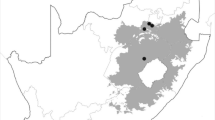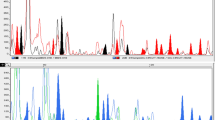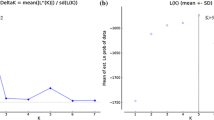Abstract
The objective of this study was to assess the genetic diversity and to infer the mode of reproduction of Botrytis elliptica and B. tulipae in the Netherlands. First, three molecular typing methods were compared for their ability to differentiate isolates of B. tulipae, B. elliptica, and B. cinerea. The methods compared were multilocus sequencing, restriction analysis of the ribosomal intergenic spacer (IGS) region, and amplified fragment length polymorphism (AFLP) analysis. AFLP fingerprinting provided the most efficient method to differentiate isolates within each Botrytis species and therefore this method was used for population analyses of B. elliptica and B. tulipae. Isolates of both species were sampled during successive growing seasons in experimental field plots in Lisse and other locations in the Netherlands. Among 174 B. elliptica isolates, 105 genotypes could be discriminated and 87 genotypes were found only once, reflecting high genotypic variation. Clonal genotypes were found only within growing seasons and in one location. Linkage disequilibrium analyses indicated that between 9.4% and 19.3% of the loci in clone-corrected samples were linked. The multilocus association index provided no evidence for random mating. We conclude that sexual recombination occurs in the B. elliptica population. Among the 170 B. tulipae isolates, 25 genotypes could be discriminated and four genotypes were found only once, reflecting a low genotypic variation. Clonal genotypes were frequently found in different growing seasons and different locations. Linkage disequilibrium analyses indicated that between 25.2% and 48.6% of the loci in clone-corrected samples were linked. We conclude that the B. tulipae population is mainly clonal with some recombination.




Similar content being viewed by others
Explore related subjects
Discover the latest articles and news from researchers in related subjects, suggested using machine learning.References
Agapow, P.-M., & Burt, A. (2001). Indices of multilocus linkage disequilibrium. Molecular Ecology Notes, 1, 101–102.
Albertini, C., Thebaud, G., Fournier, E., & Leroux, P. (2002). Eburicol 14α-demethylase gene (CVP51) polymorphism and speciation in Botrytis cinerea. Mycological Research, 106, 1171–1178.
Beever, R. E., & Weeds, P. L. (2004). Taxonomy and genetic variation of Botrytis and Botryotinia. In Y. Elad, B. Williamson, P. Tudzynski, & N. Delen (Eds.), Botrytis: Biology, pathology and control (pp. 29–52). Dordrecht, the Netherlands: Kluwer Academic Press.
Burt, A., Carter, D. A., Koenig, G. L., White, T. J., & Taylor, J. W. (1996). Molecular markers reveal cryptic sex in the human pathogen Coccidioides immitis. Proceedings of the National Academy of Science USA, 93, 770–773.
Carbone, I., Anderson, J. B., & Kohn, L. M. (1999). Patterns of descent in clonal lineages and their multilocus fingerprints are resolved with combined gene genealogies. Evolution, 53, 11–21.
Carbone, I., & Kohn, L. (2004). Inferring process from pattern in fungal population genetics. Applied Mycology and Biotechnology, 4, 1–30.
Chao, A., & Shen, T. (2003). Nonparametric estimation of Shannon’s index of diversity when there are unseen species in sample. Environmental and Ecological Statistics, 10, 429–443.
Coley-Smith, J. R., & Javed, Z. U. R. (1972). Germination of sclerotia of Botrytis tulipae, the cause of tulip fire. Annals of Applied Biology, 71, 99–109.
Daboussi, M.-J., & Capy, P. (2003). Transposable elements in filamentous fungi. Annual Review of Microbiology, 57, 275–299.
Diolez, A., Marches, F., Fortini, D., & Brygoo, Y. (1995). Boty, a long-terminal-repeat retroelement in the phytopathogenic fungus Botrytis cinerea. Applied and Environmental Microbiology, 61, 103–108.
Doornik, A. W., & Bergman, B. H. H. (1973). Some factors influencing the outgrowth of Botrytis tulipae from lesions on tulip bulbs after planting. Netherlands Journal of Plant Pathology, 79, 203–207.
Excoffier, L., Laval, G., & Schneider, S. (2005). Arlequin ver. 3.0: An integrated software package for population genetics data analysis. Evolutionary Bioinformatics Online, 1, 47–50.
Faretra, F., Antonacci, E., & Pollastro, S. (1988). Sexual behaviour and mating system of Botryotinia fuckeliana, teleomorph of Botrytis cinerea. Journal of General Microbiology, 134, 2543–2550.
Fournier, E., Giraud, T., Loiseau, A., Vautrin, D., Estoup, A., Solignac, M., Cornuet, J. M., & Brygoo, Y. (2002). Characterization of nine polymorphic microsatellite loci in the fungus Botrytis cinerea (Ascomycota). Molecular Ecology Notes, 2, 253–255.
Fournier, E., Levis, C., Fortini, D., Leroux, P., Giraud, T., & Brygoo, Y. (2003). Characterization of Bc-hch, the Botrytis cinerea homolog of the Neurospora crassa het-c vegetative incompatibility locus and its use as a population marker. Mycologia, 95, 251–261.
Giraud, T., Fortini, D., Levis, C., Leroux, P., & Brygoo, Y. (1997). RFLP markers show genetic recombination in Botryotinia fuckeliana (Botrytis cinerea) and transposable elements reveal two sympatric species. Molecular Biology and Evolution, 14, 1177–1185.
Grünwald, N. J., Goodwin, S. B., Milgroom, M. G., & Fry, W. E. (2003). Analysis of genotypic diversity data for populations of microorganisms. Phytopathology, 93, 738–746.
Holz, G., Coertze, S., & Williamson, B. (2004). The ecology of Botrytis on plant surfaces. In Y. Elad, B. Williamson, P. Tudzynski, & N. Delen (Eds.), Botrytis: Biology, pathology and control (pp. 9–27). Dordrecht, the Netherlands: Kluwer Academic Press.
Huang, J., Hsieh, T.-F., Chastagner, G. A., & Hsiang, T. (2001). Clonal and sexual propagation in Botrytis elliptica. Mycological Research, 105, 833–842.
Huson, D. H., & Bryant, D. (2006). Application of phylogenetic networks in evolutionary studies. Molecular Biology and Evolution, 23, 254–267.
Kerssies, A., Bosker-van Zessen, I., Wagemakers, C. A. M., & van Kan, J. A. L. (1997). Variation in pathogenicity and DNA polymorphism among Botrytis cinerea isolates sampled inside and outside a glasshouse. Plant Disease 81, 781–786.
Kessel, G. J. T., de Haas, B. H., Lombaers-van der Plas, C. H., van den Ende, J. E., Pennock-Vos, M. G., van der Werf, W., & Köhl, J. (2001). Comparative analysis of the role of substrate specificity in biological control of Botrytis elliptica in lily and B. cinerea in cyclamen with Ulocladium atrum. European Journal of Plant Pathology, 107, 273–284.
Levis, C., Fortini, D., & Brygoo, Y. (1997). Flipper, a mobile Fot1-like transposable element in Botrytis cinerea. Molecular and General Genetics, 254, 674–680.
Lorbeer, J. W., Seyb, A. M., de Boer, M., & van den Ende, J. E. (2004), Botrytis on bulb crops. In Y. Elad, B. Williamson, P. Tudzynski, & N. Delen (Eds), Botrytis: Biology, pathology and control (pp. 273–294). Dordrecht, the Netherlands: Kluwer Academic Publishers.
Maynard Smith, J., Smith, N. H., O’Rourke, M., & Spratt, B. G. (1993). How clonal are bacteria? Proceedings of the National Academy of Science USA, 90, 4384–4388.
McGuire, I. C., Davis, J. E., Double, M. L., MacDonald, W. L., Rauscher, J. T., McCawley, S., & Milgroom, M. G. (2005). Heterokaryon formation and parasexual recombination between vegetatively incompatible lineages in a population of the chestnut blight fungus, Cryphonectria parasitica. Molecular Ecology, 14, 3657–3669.
Milgroom, M. G. (1996). Recombination and the multilocus structure of fungal pathogens. Annual Review of Phytopathology, 34, 457–477.
Milgroom, M. G., Lipari, S. E., & Powell, W. A. (1992). DNA fingerprinting and analysis of population structure in the chestnut blight fungus, Cryphonectria parasitica. Genetics, 131, 297–306.
Moyano, C., Alfonso, C., Gallego, J., Raposo, R., & Melgarejo, P. (2003). Comparison of RAPD and AFLP marker analysis as a means to study the genetic structure of Botrytis cinerea populations. European Journal of Plant Pathology, 109, 515–522.
Nei, M. (1987). Molecular evolutionary genetics. New York: Columbia University Press.
Pollastro, S., Faretra, F., Canio, V., & De Guido, A. (1996). Characterization and genetic analysis of field isolates of Botryotinia fuckeliana (Botrytis cinerea) resistant to dichlofluanid. European Journal of Plant Pathology, 102, 607–613.
Prins, T. W., Tudzynski, P., von Tiedemann, A., Tudzynski, B., ten Have, A., Hansen, M. E., Tenberge, K., & van Kan, J. A. L. (2000). Infection strategies of Botrytis cinerea and related necrotrophic pathogens. In J. W. Kronstad (Ed.), Fungal pathology (pp. 33–65). Dordrecht, The Netherlands: Kluwer Academic Publishers.
Staats, M., van Baarlen, P., & van Kan, J. A. L. (2005). Molecular phylogeny of the plant pathogenic genus Botrytis and the evolution of host specificity. Molecular Biology and Evolution, 22, 333–346.
Van den Ende, J. E., & Pennock-Vos, M. G. (1997). Primary sources of inoculum of Botrytis elliptica in lily. Acta Horticulturae, 430, 591–595.
Van der Vlugt-Bergmans, C. J. B., Brandwagt, B. F., van’t Klooster, J. W., Wagemakers, C. A. M., & van Kan, J. A. L. (1993). Genetic variation and segregation of DNA polymorphisms in Botrytis cinerea. Mycological Research, 97, 1193–1200.
Vos, P., Hogers, R., Bleeker, M., Reijans, M., van der Lee, T., Hornes, M., Frijters, A., Pot, J., Peleman, J., Kuiper, M., & Zabeau, M. (1995). AFLP: A new concept for DNA fingerprinting. Nucleic Acids Research, 23, 4407–4414.
White, T. J., Bruns, T., Lee, S., & Taylor, J. (1990). Amplification and direct sequencing of fungal ribosomal RNA genes for phylogenetics. In M. A. Innis, D. H. Gelfand, J. J. Sninsky, & T. J. White (Eds.), PCR protocols: A guide to methods and applications (pp. 315–322). San Diego: Academic Press.
Zhonghua, M., & Michailides, T. J. (2005). Genetic structure of Botrytis cinerea populations from different host plants in California. Plant Disease, 10, 1083–1089.
Acknowledgements
The authors would like to thank Dr. Kim M. Plummer and Dr. Ioannis Stergiopoulos for critically reading the manuscript. We are grateful to Marjan de Boer and Ineke Pennock (PPO Lisse) for allowing us to sample in their experimental field and for excellent technical advice. Fien Meijer-Dekens, Petra van den Berg, Marleen Höfte, David Tena Marin and Ronald Wilterdink are acknowledged for technical assistance. This research was funded by the Dutch Technology Foundation STW, applied science division of NWO and the technology programme of the Ministry of Economic Affairs (project WEB5564).
Author information
Authors and Affiliations
Corresponding author
Rights and permissions
About this article
Cite this article
Staats, M., van Baarlen, P. & van Kan, J.A.L. AFLP analysis of genetic diversity in populations of Botrytis elliptica and Botrytis tulipae from the Netherlands. Eur J Plant Pathol 117, 219–235 (2007). https://doi.org/10.1007/s10658-006-9085-5
Received:
Accepted:
Published:
Issue Date:
DOI: https://doi.org/10.1007/s10658-006-9085-5
Keywords
Profiles
- J. A. L. van Kan View author profile




